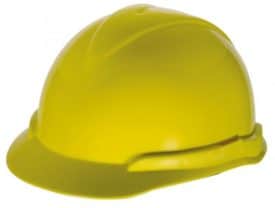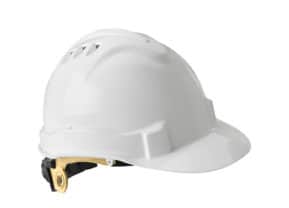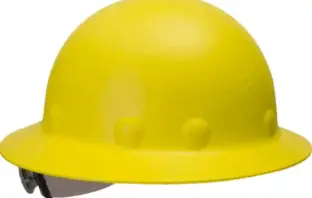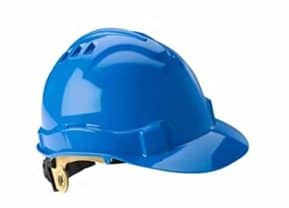 Construction sites pose a major threat for the workers, be it small injuries or be fatal ones.
Construction sites pose a major threat for the workers, be it small injuries or be fatal ones.
Workers need safety guards to protect themselves from the pending hazards.
And when it comes to protecting the head, one needs to be even more cautious!
And construction helmets are just apt for the purpose and are the ones you definitely cannot go without in a construction site.
But there are different color codes of construction helmets which the site workers need to follow on a strict note according to the British standard BS EN 397.
The white color is used for competent operatives, site managers, vehicle Marshalls. The black color is used for supervisors. The orange color is used for signalers and slingers. The blue color is used for visitors, inexperienced persons, apprentice, and architect. The green color is used for first aider. The red color is used for Fire Marshall.
Also there are two more color codes which are as follows:
The brown color is for welders and workers who work with high heat application. The yellow color is for the laborers and those who work as earth moving operators.
In this article I am going to tell you in details all about safety helmets, their color coding and the OSHA, ANSI & CSA standards.
Let’s begin with the comparison of different color codes safety helmet:
Benefits of Using Color Codes for Safety Helmets:
Though there is no mandate that you have to have to offer separate helmet colors to the workers working in separate fields, at least, you won’t be jailed for doing so, yet there are certain advantages of using different color codes for safety helmets which we are going to list below:
1.) When different colors are assigned to different job segments, it will be easy for you to identify them in case of emergency situations.
2.) It will be easy to spot the workers working on a particular assignment.
3.) It will be easier to spot the workers when they are scattered here and there.
4.) Different helmets have different parameters of safety. Each helmet belonging to a particular color is designed to protect your head from a particular type of injury.
5.) A helmet designed for supervisors will not be made that strong as that of a laborer.
6.) It protects the head from any falling objects.
7.) It protects the head from injuries against sharp objects.

What will happen if you do not follow the color code?
-
-
- Things will be messier for you.
- You will NOT be able to spot the particular category of workers in emergency situations. For example, if there is an electrical short circuit, you will need to assemble the electrical department. If they are assigned with particular colored helmets, the work of spotting them and assembling them quickly will be easier.
-
What are the General Standards of a Safety Helmet?
 Standards are actually the essential features that must be there in a safety helmet:
Standards are actually the essential features that must be there in a safety helmet:
-
-
- It should be heat or flame resistant
- It should be able to protect against electrical shocks
- It must have shock absorption feature
- It must be water resistant
- It must be puncture resistant
- It must not be fragile
- It should pass the impact and compression tests
-
ANSI Color Code for Safety Helmets:
According to the American National Standards Institute (ANSI), the different color codes symbolize the following:
What does the Red color construction helmet mean?
The red construction helmet is used for fire protection which pause high risk injuries.
What does the Yellow construction helmet mean?
The yellow construction helmet is used for caution statements with minor risks.
What does the Orange construction helmet mean?
The orange construction helmet is used for guarding services with moderate risks.
What does the Green construction helmet mean?
The green construction helmet is used for safety or first aid equipments handling.
What does the Blue construction helmet mean?
The blue construction helmet is used for the least hazardous activities.
What does the white color construction helmet mean?
The white construction helmet is used for handling poisonous and toxic materials.
What does the black construction helmet mean?
The black hard hat or the black color helmet is worn by the site supervisor in the construction industry.
The black color hard hats offer all-round protection to the supervisor who is under the risk of head injuries while the supervision of the site activities.
These hard hats come in two different styles; the cap style and the full brim style. The black hard hats meet the OSHA ANSI Z89.1-2009 standards.
Also, colors specify the particular materials used in constructions, which are as follows:
-
-
- White: for poisonous or toxic materials
- Green: for non-flammable gases
- Yellow: for oxidisers
- Red: for combustible materials
- Orange: for explosives
- Red and white stripes: for flammable solids
-
What are the OSHA guidelines for safety helmets/hard hats?
According to the OSHA guidelines as mentioned in 29 CFR 1910.135, head protection is required in the following hazardous situations:
-
-
- If situation is so that there is any chance of heavy objects falling from above and striking ones head.
- If there are fixed objects above the head like exposed beams or pipes, workers might bump their head against those objects.
- If there is any chance of accidental contact of the head with electrical hazards.
-
There are generally two standards that are followed globally for hard hats or safety helmets and those are:
These two standards state the “TYPE” & “CLASS” descriptors, which enable to ensure that the right hat is assigned for the selection application.
The types and classes stated by both the standards are as follows:
TYPE 1: ANSI helmets concentrate on reducing the force of impact from a blow that would cover only the top of the head. CSA helmets concentrate on reducing impact and provide protection to the crown area only.
ANSI helmets concentrate on reducing the force of impact from a blow that would cover only the top of the head. CSA helmets concentrate on reducing impact and provide protection to the crown area only.
TYPE 2: ANSI helmets are designed to withstand blow from top as well as the sides of the head. CSA helmets are designed to protection for crown and lateral parts.
ANSI helmets are designed to withstand blow from top as well as the sides of the head. CSA helmets are designed to protection for crown and lateral parts.
CLASS C: ANSI helmets do not offer electrical hazard protection. CSA helmets do not offer dielectric protection.
ANSI helmets do not offer electrical hazard protection. CSA helmets do not offer dielectric protection.
CLASS G:

ANSI helmets provide protection against low-voltage conductors (2200 volts). CSA helmets are non-conducting and are required to pass the dielectric strength test of 2200 volts for 1 minute.
CLASS E: ANSI helmets provide protection against low-voltage conductors (20000 volts). CSA helmets are non-conducting and are required to pass the dielectric strength test of 20000 volts for 3 minutes.
ANSI helmets provide protection against low-voltage conductors (20000 volts). CSA helmets are non-conducting and are required to pass the dielectric strength test of 20000 volts for 3 minutes.
What are standard testing requirements of ANSI & CSA head protection?
ANSI requires the following tests:
-
-
- Apex penetration
- Flammability
- Force transmission
- Electrical insulation
- Impact energy attenuation
- Off-centre penetration
- High visibility
- Chin-strap test
- Low temperature test
- Reverse wearing test
-
Tests are conducted for temperature resistance from 49 degrees C to -18 degrees C.
CSA requires the following tests:
-
-
- Impact attenuation
- Dielectric strength
- Passive retention
- Liner ignition resistance
- Shell flammability
- Penetration resistance
- Ignition resistance
- Reverse orientation
-
Tests are conducted for temperature resistance from 50 degrees C to -30 degrees C.
Before we say Good Bye:
It is very important to follow the color codes of safety helmets to save your workers from potential hazards and also to run the construction works smoothly and effectively.
Each color helmet is designed for a particular purpose and you have to understand its importance in that particular situation alone.
Different countries have different color codes and we have mentioned about 3 of them in this article, which are acknowledged globally.
Hope this article was helpful to you. We will be right back with another piece of informative writing. Till then take care and…
Work with safety!













